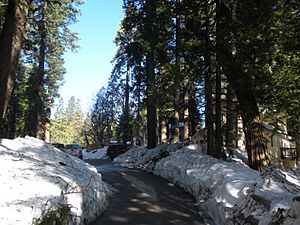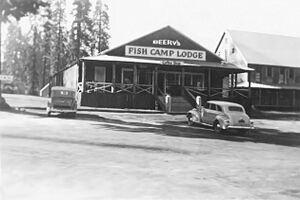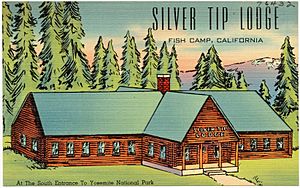Fish Camp, California facts for kids
Quick facts for kids
Fish Camp
|
|
|---|---|
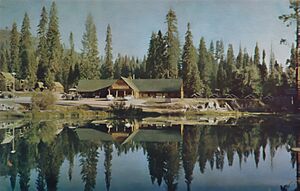
Silver Top Lodge, Fish Camp, 1940s
|
|
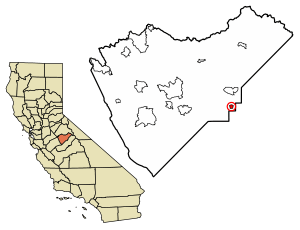
Location in Mariposa County, California
|
|
| Country | |
| State | |
| County | Mariposa |
| Area | |
| • Total | 0.402 sq mi (1.04 km2) |
| • Land | 0.400 sq mi (1.04 km2) |
| • Water | 0.002 sq mi (0.005 km2) 0.50% |
| Elevation | 5,062 ft (1,543 m) |
| Population
(2020)
|
|
| • Total | 49 |
| • Density | 122.5/sq mi (47.3/km2) |
| Time zone | UTC-8 (Pacific (PST)) |
| • Summer (DST) | UTC-7 (PDT) |
| ZIP Code |
93623
|
| GNIS feature IDs | 260142 2583013 |
| FIPS code | 06-24218 |
Fish Camp is a small community in Mariposa County, California. It used to be called Happy Camp and Berry's Fish Camp. This place is about 18 miles (29 km) east of Mariposa. It sits high up at 5,062 feet (1,543 meters) above sea level.
In 2020, only 49 people lived there. The area's ZIP Code is 93623.
Fish Camp is famous for its history of cutting down trees (logging). It's also a main entrance to Yosemite. Over time, it has become a popular spot for visitors. Today, you can find the historic Yosemite Mountain Sugar Pine Railroad and the fancy Tenaya Lodge here. This shows how Fish Camp changed from a logging town to a fun place for tourists.
The Fish Camp post office first opened in 1924. It closed for a while in 1933, then opened again in 1939. The name "Fish Camp" comes from a place where fish were raised nearby.
Contents
About Fish Camp's Location
Fish Camp is a "census-designated place" (CDP). This means it's a community that the government counts for population, but it's not officially a city or town.
Land and Climate
The area of Fish Camp is about 0.9 square miles (2.3 square kilometers). Almost all of this area is land.
Fish Camp has a type of weather called a Mediterranean climate. This means it has warm, dry summers. The average monthly temperature in summer doesn't go above 71.6 °F (22 °C).
Fish Camp's History
Fish Camp grew a lot in the late 1800s. This was because of the logging industry and the many tourists visiting Yosemite Valley.
Stagecoach Travel
Fish Camp's story began in 1875. That's when the Wawona stagecoach road to Yosemite Valley opened. Fish Camp became an important stop for travelers. It was even a target for stagecoach robbers sometimes!
Logging Industry
The first people to settle permanently in Fish Camp came to support the logging industry.
The Madera Sugar Pine Company cut down many trees in the forests around Fish Camp. This wood was needed for building in California in the late 1800s. The logging changed the land. It also created open areas that sheep herders later used for their animals.
Hotels and Places to Stay
For over 100 years, Fish Camp has been a mountain stop for people going to Yosemite.
In 1883, a local businessman named Albert Phillip built a two-story hotel. It had 12 bedrooms, a kitchen, a dining room, and a sitting area. Phillip also ran a service that carried goods between Raymond and Yosemite Valley. He even moved ore from a nearby mine using teams of ten animals.
By 1925, Charles Beery took over the property. He turned it into a resort called Beery's Paradise Lodge. But the lodge had several fires. The last one happened in 1942. After that, the property was sold in 1943.
The new owners built The Silver Tip Lodge. It was open for 35 years until it was destroyed by a fire in 1981. The lodge was known for its fun community events. These included an annual turkey shoot and barbecues with local bear meat.
In 1990, the Marriott Corporation opened the Tenaya Lodge. This is a large, fancy resort with 242 rooms. It made the area even better for tourists. Today, a company called Delaware North runs the lodge.
Who Lives in Fish Camp?
The 2010 United States Census counted 59 people living in Fish Camp. Most of the people (96.6%) were White. About 5.1% of the people were Hispanic or Latino.
All 59 people lived in homes. There were 31 households in total. About 12.9% of these homes had children under 18. Many homes (41.9%) had just one person living there. The average household had 1.90 people.
The median age of people in Fish Camp was 49.2 years old. This means half the people were younger than 49.2, and half were older.
There were 153 housing units in Fish Camp. Most of the homes (64.5%) were owned by the people living in them. The rest (35.5%) were rented.
Fun Things to Do
Yosemite Sugar Pine Railroad
The Yosemite Mountain Sugar Pine Railroad is a historic train ride near Fish Camp. It started running in 1967. This railroad uses old steam locomotives. It's a popular tourist attraction that follows the old path of the Madera Sugar Pine Lumber Company.
See also
 In Spanish: Fish Camp para niños
In Spanish: Fish Camp para niños




